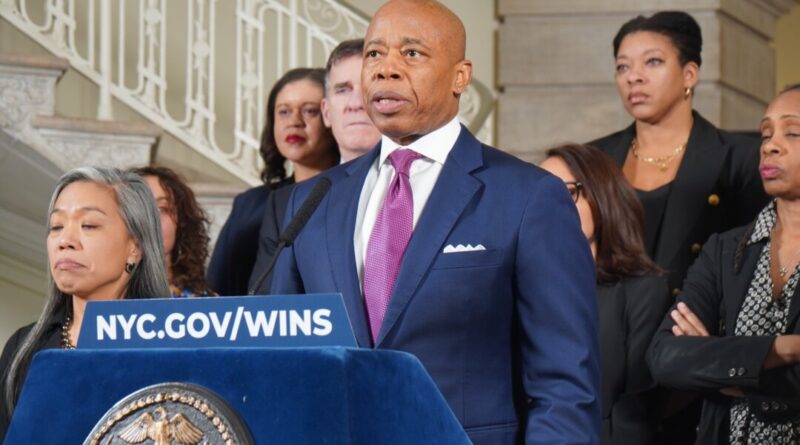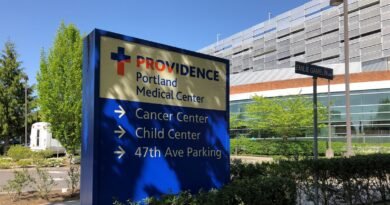Highlights from the New York Mayor’s Preliminary Budget Announcement
Mayor Eric Adams announced that the city has incurred lower expenses than anticipated regarding the migrant crisis, allowing additional funding for the upcoming fiscal year.
NEW YORK CITY–On January 16, Mayor Eric Adams presented the city’s preliminary budget for 2026, highlighting significant savings on migrant-related costs, which have resulted in hundreds of millions available for new expenditures.
In a live-streamed presentation, Adams disclosed a proposed budget of $114.5 billion, representing a $2.5 billion increase compared to the current fiscal year. The city has also carried over an additional $2.4 billion from last year’s budget due to lower-than-expected migrant spending.
“Due to a combination of federal policies managing influxes and city strategies to assist families in exiting shelters, we’ve stabilized the emergency situation, with 28 consecutive weeks of declining census numbers,” the city stated.
The mayor attributed the lack of major funding cuts in the budget to what he termed “strong financial management” and robust tax revenues stemming from a prosperous year on Wall Street.
“Our strong fiscal management coupled with our investments in making this a safer, more affordable city enables us to position New York City as the ideal place to raise a family,” Adams commented.
‘City of Yes’ for Housing
The budget allocates $137 million for addressing homelessness in Fiscal Year (FY) 2026, starting July 1. This funding aims to create 900 Safe Haven beds and enhance outreach services on the streets and in subway systems. Additionally, it will finance 100 more shelter beds for runaway and homeless youth.
Other allocations include $325 million for rental assistance and $64.2 million for supportive housing initiatives.
“We are also launching a new initiative. No child should ever have to enter our shelter system,” Adams stated. To achieve this, a pilot program connecting soon-to-be parents with permanent housing will be introduced.
The mayor emphasized one of his significant initiatives, New York’s “City of Yes for Housing Opportunity,” which is set to invest $5 billion over the next 15 years into housing and infrastructure, aiming to create up to 80,000 new homes.
‘Axe the Tax’
Adams introduced the “Axe the Tax for the Working Class” plan, designed to eliminate the New York City personal income tax for individuals with dependents living at or below 150 percent of the federal poverty level. Additionally, it aims to gradually phase out the city personal income tax for those just above this threshold.
New York City is one of the few cities in the United States that imposes a local income tax in addition to state income tax. The city’s income tax rates vary between 3.078 percent and 3.876 percent, depending on income.
According to Adams, this program will return over $63 million back to more than 582,000 New Yorkers.
Quality of Life
A significant portion of the budget will focus on enhancing quality of life.
This includes $12.4 million for a second cleaning shift at an additional 100 hotspots in 64 parks.
Investment in recreation staff will support the newly opening Shirley Chisholm Recreation Center and help establish five more Cultural Institutions Groups (CIGs), which include the Bronx Museum of the Arts and the Brooklyn Academy of Music.
Another allocation will improve city tree beds, which are a known habitat for the city’s rat population, through additional staff to treat 4,000 tree beds annually, alongside managing public service requests.
Ten Year Capital Plan
The city plans to invest $170 billion over the next decade into infrastructure, including roads, bridges, schools, and sewage systems throughout all five boroughs, as stated by the mayor.
As part of the city’s largest-ever ten-year capital plan, $36.5 billion will be directed towards the NYC Department of Environmental Protection and the Department of Sanitation, $32.1 billion will support transportation, and $24.5 billion will be allocated for affordable housing. The remainder will be distributed among schools, government infrastructure, parks, and libraries.
Among the plan’s significant investments is the $3.18 billion Newtown Creek combined Sewer Overflow Storage Tunnel, designed to prevent over 1.2 billion gallons of sewage from contaminating Newtown Creek each year.
Another vital investment will allocate $1 billion towards housing initiatives through the NYC Department of Housing and Preservation Development, with $825 million aimed at the Department of Housing and Preservation Development, and $175 million for the Housing Authority.
Education
The proposed budget includes millions earmarked for educational programs, such as $100 million for the Summer Rising academic and enrichment program, $31 million for the Learning to Work initiative, $17.5 million for the career readiness Pathways program, and $15 million for various supportive educational programs.
However, several initiatives from the FY2025 budget will not transfer into the FY2026 preliminary budget, including $112 million for the city’s universal 3-K program, $41 million for arts education, $12 million for restorative justice programs, and $10 million for teacher recruitment.
Additionally, a $25 million supplemental litter basket service and the $10.8 million “Fair Fares” program, which provided qualified low-income residents with discounted metro cards, have also been omitted.
Critics
Critics have labeled the mayor’s budget as unrealistic.
Andrew Rein, president of the Citizens Budget Commission, a nonprofit oversight group, stated that the spending plan “does not reflect reality—it is short nearly $4.0 billion needed to fund existing services.”
Rein urged the Adams administration to overcome what he called a “severe underbudgeting habit” and provide a transparent view of the city’s fiscal situation.
The mayor will engage in discussions with the City Council over the next few months to finalize the budget agreement.





